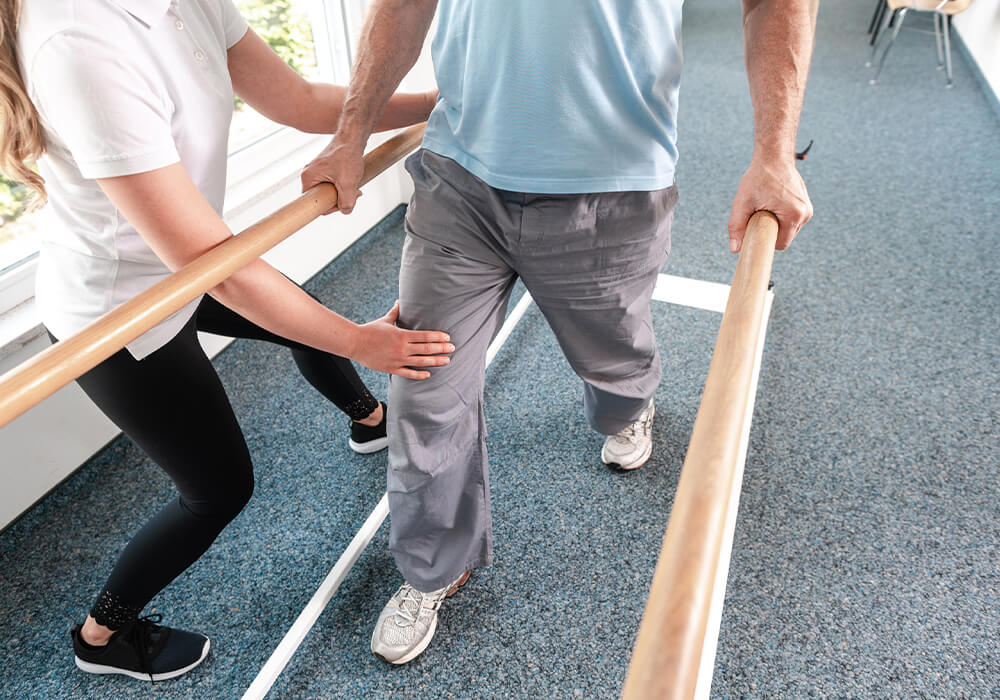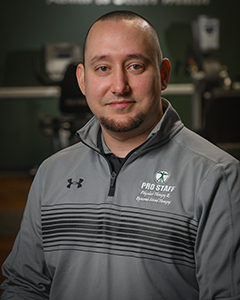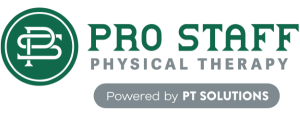Balance and Stability: The Role of Physical Therapy in Fall Prevention
According to the Centers for Disease Control and Prevention (CDC), every second of every day, an older adult suffers a fall in the United States. Falls can result in minor to severe injuries, diminished independence and confidence, and, in worst-case scenarios, can be fatal. The good news? Many falls are preventable with expert physical therapy.

What is Fall Prevention?
Falls aren’t always just accidents; they often signal underlying health issues or deficits in physical function. The reasons can be multifaceted, from frailty, poor vision, medication side effects, and environmental hazards. Regardless of the cause, the consequences can be detrimental, leading to fractures, reduced mobility, or chronic pain. This makes fall prevention important, especially for older adults and those with compromised physical conditions.
Physical therapy for fall prevention is based on balance and stability.
- Balance refers to our ability to maintain our body’s center of mass over its base of support. It involves the coordination of various sensory inputs (vision, vestibular system, proprioception) and motor outputs to achieve equilibrium.
- Stability is the ability to control our body’s position in space to remain upright, whether we’re static or in motion.
Together, these form the foundation of our everyday movements – from getting out of bed to walking and standing in place.
The Role of Physical Therapy
Pro Staff Physical Therapy’s commitment is rooted in a holistic approach, ensuring that patients recover and prevent future falls.No two people are alike, and neither are their physical needs or challenges. At Pro Staff Physical Therapy, we emphasize thorough and detailed assessments to understand specific balance or stability challenges our patients face. These evaluations aren’t just about pinpointing weaknesses and understanding your lifestyle, daily activities, and goals to create tailor-made intervention plans. By focusing on enhancing balance, stability, and overall physical function, physical therapy for fall prevention often includes:
Strength Training: Strength training is crucial in fall prevention, especially in older adults. Strengthening the muscles, particularly those of the lower extremities, enhances stability and improves balance. Here are some examples of strength training exercises tailored for fall prevention:
- Squats
- Purpose: Strengthen the quadriceps, hamstrings, and glutes.
- How-to: Stand with feet shoulder-width apart. Keeping the back straight and chest up, lower the body as if sitting in a chair. Return to the starting position and repeat.
- Lunges
- Purpose: Work the quadriceps, hamstrings, and calf muscles.
- How-to: Stand upright, step forward with one leg, and lower the hips until both knees are bent at a 90-degree angle. Push back up to the starting position and repeat with the other leg.
- Heel Raises
- Purpose: Strengthen the calf muscles.
- How-to: Holding onto a support, lift heels off the ground by pushing through the balls of the feet. Lower the heels back down and repeat.
- Leg Curls
- Purpose: Strengthen the hamstrings.
- How-to: Using a resistance band or a leg curl machine at the gym, curl the heels towards the glutes. Slowly return to the starting position and repeat.
- Leg Extensions
- Purpose: Strengthen the quadriceps.
- How-to: While seated, extend one leg out in front. Return to the starting position and repeat with the other leg.
- Step-Ups
- Purpose: Work the quads, hamstrings, and glutes.
- How-to: Using a low step or bench, step up with one foot followed by the other, then step down in the same sequence.
- Bridges
- Purpose: Target the glutes, hamstrings, and lower back.
- How-to: Lying on the back with knees bent, feet flat on the floor, lifting the hips off the ground, squeezing the glutes. Lower and repeat.
Balance Exercises: Balance is dynamic, changing with every movement. Pro Staff offers a range of exercises that continuously challenge and hone your balance control. Starting with foundational exercises like weight-shifting, patients gradually progress to advanced tasks like single-leg stands and tandem walking. Each activity is chosen based on current capabilities, ensuring safety while encouraging you to push your boundaries.
- Single Leg Stance
- Purpose: Improve balance on one leg.
- How-to: Hold onto a sturdy chair or surface. Stand on one leg, lifting the other foot off the ground. Hold the position for a few seconds, gradually increasing the duration as balance improves. Switch to the other leg and repeat.
- Heel-to-Toe Walk
- Purpose: Enhance walking balance and coordination.
- How-to: Walk in a straight line, placing the heel of one foot directly in front of the toes of the other foot each time you take a step.
- Tandem Stand
- Purpose: Improve stability in a narrow base of support.
- How-to: Stand with one foot directly in front of the other so the toes of one foot touch the heel of the other. Hold this position, then switch foot positions.
- Side Leg Raises
- Purpose: Strengthen hip abductors and enhance lateral balance.
- How-to: Holding a sturdy chair, stand on one leg and lift the other leg out to the side. Lower it without letting it touch the floor between repetitions.
- Balance Walk
- Purpose: Enhance balance and coordination.
- How-to: Raise arms to the side at shoulder height. Walk in a straight line, pausing for one or two seconds at each step.
- Clock Reach
- Purpose: Train multi-directional balance.
- How-to: Imagine standing in the center of a clock. Without lifting the heels off the ground, reach forward to 12 o’clock (noon), then reach back to 6 o’clock. You can also go to the 3 o’clock and 9 o’clock positions. Switch feet and repeat.
Gait and Mobility Training: Gait refers to how you walk and can be a tell-tale sign of stability. Abnormal gait patterns can be a precursor to potential falls. Pro Staff physical therapists conduct detailed gait analysis, identifying any abnormalities or inefficiencies to provide targeted training to rectify these issues.
Environmental Education: While internal factors like balance and muscle strength play a significant role, external factors, particularly environmental hazards, should not be overlooked. Pro Staff therapists can provide valuable education on recognizing these hazards and strategies to mitigate them to empower individuals to create safer living spaces, reducing the risk of environmental-induced falls.
Technological Interventions: At Pro Staff Physical Therapy, we harness modern tools to enhance treatment outcomes. Devices like balance platforms, for instance, provide invaluable real-time feedback on weight distribution and postural nuances. This instant feedback allows for immediate corrections, ensuring exercises are effective and performed with precision.
Psychological Training: The fear of falling can be paralyzing, leading individuals to limit their activities. This reduced activity can, ironically, increase fall risk due to muscle weakening. Physical therapy not only restores physical balance and strength; it also rebuilds confidence, ensuring individuals lead active, fulfilling lives without fearing falling.
Stand Tall with Pro Staff Physical Therapy
Balance and stability are the foundation of our daily mobility and independence, and the terrain can get rough as we navigate life. While age is undoubtedly a significant factor in fall risk, compromised balance and stability can affect anyone. Early intervention is crucial whether you’ve had a near-fall experience, feel unstable when moving, or have started to avoid certain activities due to fear of falling.
Don’t let the fear of falling stop you from living your life. Prioritize your safety, embrace the expertise, and stand tall with Pro Staff Physical Therapy by your side. For questions or to schedule an appointment, visit our website or call 1.844.REHABPT (734.2278).
Pro Staff Institute, LLC, has a network of outpatient physical rehabilitation centers in New Jersey. Pro Staff was founded in 2010 by Frank Pavlisko and Michael Maffucci. Through Frank’s 25 plus years experience in Physical Therapy and Michael’s experience in Management Services, our goal is to exceed customer expectations by providing the highest quality of service in a fun, family, friendly, and encouraging environment.
PRO STAFF LOCATIONS
OFFERING CERTIFIED
HAND THERAPY
Managing Diabetes: The Role of Physical Therapy
Managing Diabetes: The Role of Physical Therapy As of 2024, approximately 38.4 million Americans, or 11.6% of the U.S. population, have diabetes. Of these, 29.7 million cases are diagnosed, while an estimated 8.7 [...]
Staying Active and Injury-Free During Summer Activities
Staying Active and Injury-Free During Summer Activities Summer is a fantastic time to engage in outdoor sports and physical activities. Whether playing soccer, tennis, cycling, or jogging in the park, staying active is [...]
The Importance of Posture: How Proper Alignment Can Prevent Pain and Injury
The Importance of Posture: How Proper Alignment Can Prevent Pain and Injury In today's fast-paced world, where many hours are spent over desks, smartphones, and computers, posture is often neglected. Poor posture can [...]




